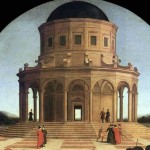 Sacred Spaces, Secular Acts (Bruges, 18 – 20 Aug 16) Bruges, August 18 – 20, 2016 Deadline: Feb 1, 2016
Sacred Spaces, Secular Acts (Bruges, 18 – 20 Aug 16) Bruges, August 18 – 20, 2016 Deadline: Feb 1, 2016
CFP Sixteenth-Century Society Conference, Bruges (August 18-20, 2016) Panel: Sacred Spaces, Secular Acts: Non-Religious Functions of Italian Church Buildings The Italian church interior in the early modern period witnessed far more than mere religious rite. As a venue for courtship rituals, dances, theatrical performances, political meetings, legal business and even sexual encounters, churches were versatile, multi-functional spaces which could change their purpose and ambience in response to distinct activities. Conservative ecclesiastics such as Archbishop Antoninus of Florence, San Bernardino da Siena and Fra Savonarola condemned such acts, indirectly confirming their widespread practice. Further evidence is provided by notarial documentation, which often specified the precise ecclesiastical location where legal or political meetings took place; other written records relating to specific non-religious events; and literary and visual sources. But despite this wealth of evidence describing secular activity, scholars still tend to interpret churches – and the images and objects they contained – largely for their religious functions. While the domestic sphere is increasingly considered for its devotional components, non-religious activities in church have been noted anecdotally but rarely for their own merits. This panel will place such activities at the centre of investigation, seeking to address diverse issues related to function, access and audience. How precisely were the church’s main and sub-spaces used for these events? Could the church building function in different ways at precise times of the day or year? What do these activities reveal about the potential for diverse members of society – in particular women – to access spaces normally reserved for clergy? Topics for papers could include, but are not limited to, analysis of:
• New archival evidence on the types of non-religious activities which took place in church
• Depictions or descriptions of non-religious activities in church
• Complaints and exhortations against certain behaviours
• How secular and sacred values intersected in the church interior
• How these non-religious activities relate to issues of class, gender and status
• Works of art, music, or literature which responded to this use of space Please email 250-word paper proposals together with a curriculum vitae to Joanne Allen (jmallen@american.edu) by February 1st 2016.

Leave a Reply
You must be logged in to post a comment.